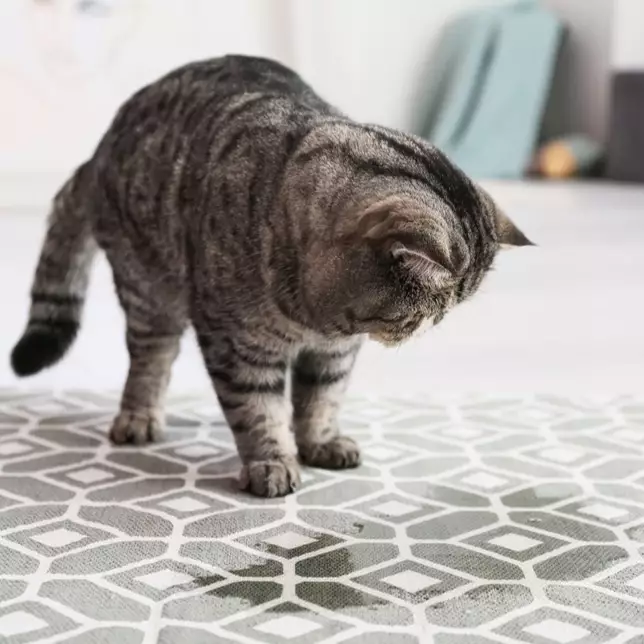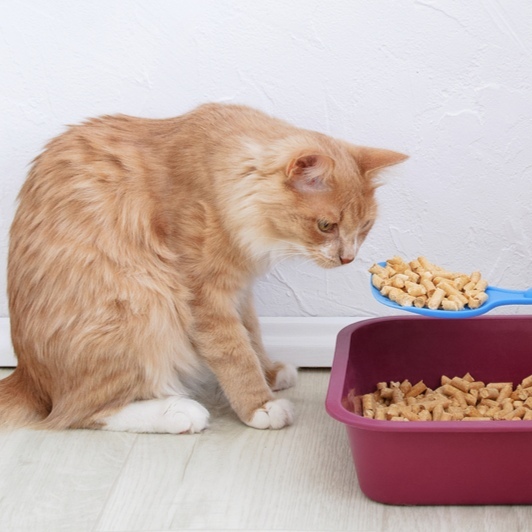Abscess from a bite in cats and dogs
What is an abscess from a bite?
An abscess is defined as a localised accumulation of pus within the tissues of the body; basically, it is a sac of infection underneath the skin. Pus is a thick, yellow-tinged liquid that collects at the site of an infection, consisting mainly of fluid and dead white blood cells, cell tissue and bacteria.
An abscess from a bite wound is a fairly common occurrence in animals that have been bitten by another animal, especially in outdoor cats. Most abscesses are the result of wounds that puncture the skin and bury bacteria from the biter’s mouth below the skin of the bitten animal. In wounds that bleed freely and easily, these bacteria have a better chance of leaving the body. However, where the wound seals up quickly or is only a tiny a puncture, the bacteria will remain under the skin, subsequently causing infection. The formation of an abscess is the body’s immune response to the foreign bacteria.
For cats in particular, seemingly insignificant bites from other cats can lead to serious consequences for the victim. Apart from abscessing, a bite wound can expose the bitten cat to contagious diseases called retroviruses from other cats. The most common retroviruses are feline leukaemia virus (FeLV) and feline immunodeficiency virus (FIV). Both viruses cause serious fatal diseases and are easily transmitted through bite wounds.
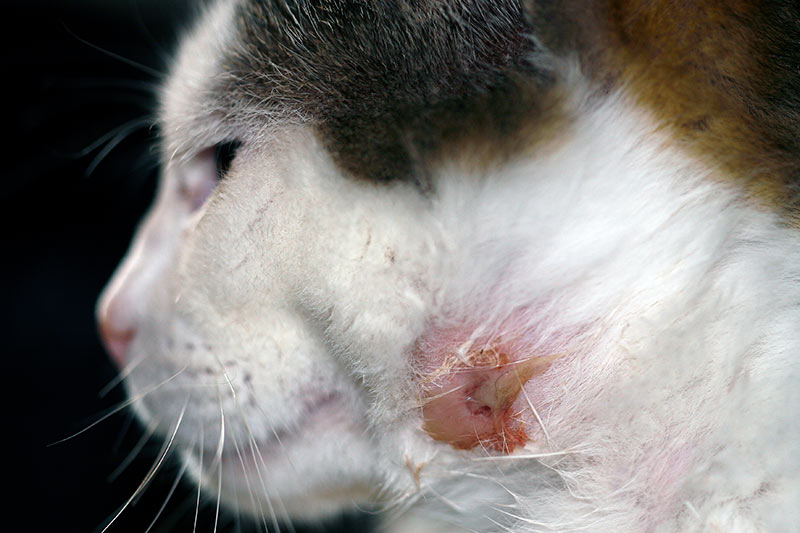
Symptoms of an abscess from a bite in cats and dogs
Commonly occurring on the face, legs and base of the tail, a bite-wound abscess usually presents as a painful, fluid-filled lump under the skin. Owners may observe a small scab over a puncture wound near the lump, but sometimes an abscess is not noticed until it breaks through the skin and oozes pus. The animal may develop a fever before the abscess is obvious and appetite and activity level may decrease.
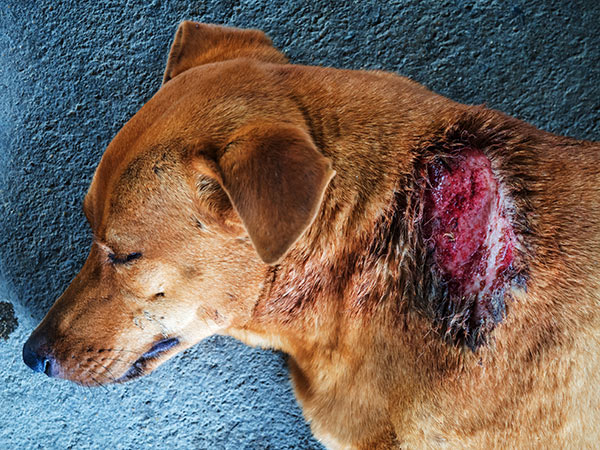
An abscess from a bite may have the following symptoms:
- A red, swollen, fluid-filled lump under the skin that is sensitive to the touch
- Heat from the site
- A bad odour from the site
- Skin rupture
- A discharge of pus oozing from the site
- Bleeding or oozing around the wound
- Hair-loss in the area
- Excessive licking or biting at the site
- Limping (if the abscess is on a limb)
- Loss of appetite
- Lethargy
- Depression
- Fever
- Pain
Causes of an abscess from a bite in cats and dogs
Abscesses are usually formed when a wound becomes infected with bacteria. Bite wounds are especially likely to abscess because of the prevalence of bacteria in the mouth and on the teeth. Cat bites are notorious for causing severe cat abscesses for two main reasons:
- Cat canine teeth are long, thin, and dagger-sharp, easily puncturing the skin and tearing into flesh.
- Several particularly pathogenic bacteria live inside a cat’s mouth, including pasteurella multocida and staphylococcus; abscesses form in response to these bacteria and many others.
An abscess from a bite wound usually occurs as a result of a fight or rough play between two cats, or even a cat and another animal. Cat abscesses occur more frequently in cats that have access to the outdoors than in indoor cats, because of the outdoor cat’s greater exposure to other animals. Cats are territorial and are more likely to fight unfamiliar cats they meet outside than familiar cats within the household. In outdoor cats, bite wounds sustained from other cats (and sometimes from wild animals) often develop into serious infections that require immediate veterinary care.
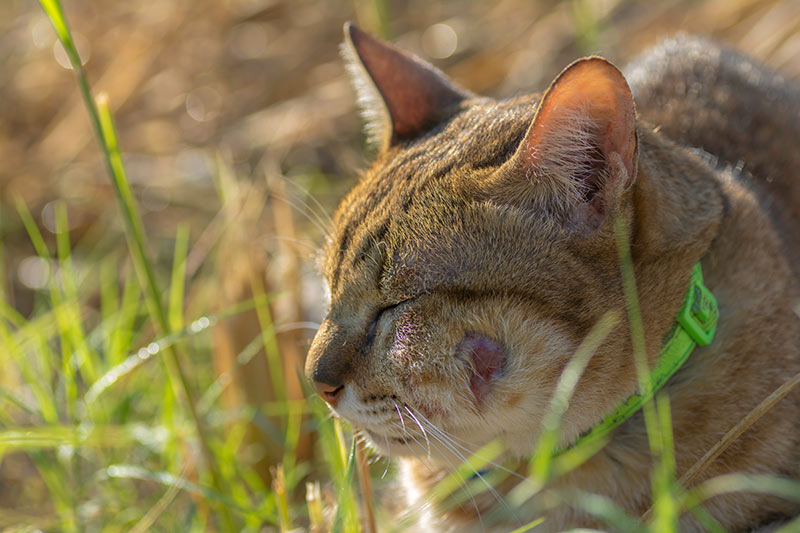
Interestingly, it is thought that cats are excellent predators partly because of their abscess-causing ability. If they fail to kill during the first attack, there is a good chance that their target will succumb to infection and be easy prey a few days later.
The more likely a dog is to get into a fight, the more likely the animal is to potentially develop an abscess on that wound.
Dog’s mouths and teeth also contain many pathogenic bacteria that can lead to abscess formation in the victim of a dog bite, including:
- Pasteurella
- Streptococcus
- Neisseria
- Corynebacterium
How is a bite abscess diagnosed?
A veterinarian will usually be able to diagnose an abscess from a bite from a physical examination and a description of the symptoms. It may be necessary to shave hair from parts of the body to look for bite wounds. Occasionally, a tiny bite wound in the early stages of infection may evade detection.
The vet will often puncture a swelling with a sterile needle to obtain a sample of pus so as to positively identify the swelling as an abscess. A sample of the fluid may be sent to a microbiology laboratory for culture and sensitivity testing.
Diagnostic testing may be undertaken prior to treatment, including:
- Chemistry tests to evaluate kidney, liver, and pancreatic function
- A complete blood count (CBC) to rule out blood-related conditions
- Electrolyte tests to identify if the animal is dehydrated or suffering from an electrolyte imbalance
- An FeLV test to identify if a cat has feline leukaemia
- An FIV test to identify if a cat has contracted the feline immunodeficiency virus
- Cardiac tests to rule out heart-related issues
Prognosis
Most dog and cat abscesses caused by a bite heal well with proper treatment, however, abscesses can be very serious if left untreated. Once an abscess forms, it is very difficult for the body to fight the infection unassisted, and an untreated abscess can lead to deeper and more widespread infection. Even when the abscess ruptures and drains on its own, recurrence is extremely common without veterinary care. Animals with bite abscesses can also get sick enough to stop eating and become severely dehydrated. Prompt medical attention is a must for all bite wounds and resultant abscesses.
Treatment for an abscess from a bite in dogs and cats
The animal should be treated by a veterinarian as soon as the possibility of an abscess is identified. Most external abscesses can be treated as a straight-forward, out-patient procedure, although occasionally anaesthesia will be required.
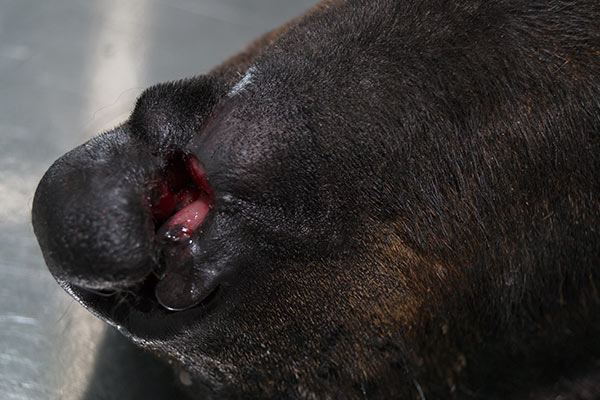
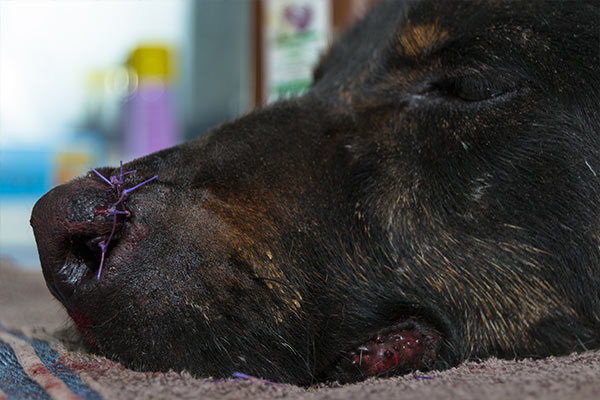
The area surrounding the abscess will generally need to be sterilised and shaved. The abscess is lanced, or punctured, to release the pus and the wound is flushed and cleaned. A sterile rubber drain is inserted to allow the infectious material to continue to drain out for a few days. Without the drain, the skin can seal before the underlying tissue is free of infection, which could lead to another abscess forming. An Elizabethan collar or bandages may be required to prevent the animal from licking and chewing at the wound.
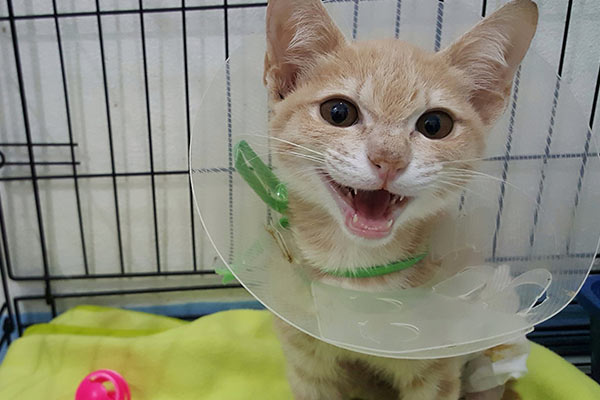
Because an abscess is a bacterial infection, an antibiotic injection and / or oral antibiotics are usually necessary. Anti-inflammatories and pain-relief medications may also be prescribed.
Preventative measures:
- Especially for cats, keep them indoors or supervised if outdoors, so they are less likely to get into a fight
- Check animals with unsupervised outdoor access regularly for injuries
- Consult your vet if you notice a wound
- Ensure that your pet’s vaccinations are kept up-to-date (learn more about cat/kitten vaccinations and dog/puppy vaccinations)
In summary
An abscess is a localised pocket of infection. An abscess from a bite results when bacteria from the mouth and teeth invade a bite wound and infect the tissues below the skin. Animals that spend time outdoors are at greater risk for developing an abscess because of their exposure to other animals. During fights, cats in particular can inflict deep bite wounds that frequently become infected and form an abscess.
Signs of a dog or cat abscess include fever, lethargy, loss of appetite, pain and the appearance of a swollen area under the skin, or the skin may rupture, leaking foul-smelling pus onto the fur. Treatment usually includes lancing, cleaning and draining the abscess, as well as antibiotics to fight the infection and prevent further infection.
Bow Wow Meow Pet Insurance can help protect you and your pet should an unexpected trip to your vet occur.
- Find out more about our dog insurance options
- Find out more about our cat insurance options
- Get an instant online pet insurance quote
Bow Wow Meow is proud to have been awarded winner of Canstar’s ‘Most Satisfied Customers’ Award in the Pet Insurance category for both 2024 and 2025!
Bow Wow Meow is proud to have been chosen as Product Review’s Pet Insurance Award Winner every year from 2018 to 2025! This is based on 2,995 independent customer reviews (as at 21/01/2025), with an overall rating of 4.3*
Google Review rating = 4.5* (based on 968 reviews)
Trust Pilot rating = 4.6* (based on 531 reviews)
Bow Wow Meow is proud to have been chosen as Product Review’s Pet Insurance Award Winner every year from 2018 to 2025! This is based on 2,995 independent customer reviews (as at 21/01/2025), with an overall rating of 4.3*
Google Review rating = 4.5* (based on 968 reviews)
Trust Pilot rating = 4.6* (based on 531 reviews)
Bow Wow Meow has been chosen as a winner in the Finder Pet Insurance Awards 2024. Finder’s panel of experts analysed over 140 quotes to award our Ultimate Care Plan the winner of the “Pet Insurance – Value” category.
More information
http://www.pethealthnetwork.com/cat-health/cat-diseases-conditions-a-z/abscesses-cats
http://websource.4act.com/chaparralvet/?p=2897
https://dogtime.com/dog-health/52857-abscesses-dogs-causes-symptoms-treatments




